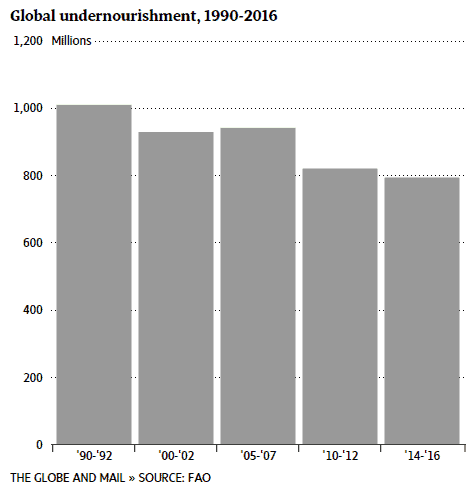The number of hungry people worldwide has dropped to 800 million, down from a billion more than a quarter century ago. Progress in Latin America and East Asia accounts for the massive reduction in the number of undernourished people, but the UN warns there are still many challenges that need to be overcome if world hunger is to end by 2030. The report proposes rich countries divert more of their resources to poorer environments, while vulnerable countries need to invest more in social protection schemes, incentives for rural areas and promote peace in conflict ridden countries like those in Africa. Sub-Saharan Africa still has the highest level of undernourishment in the world – almost one in four people there do not have access to enough food.
795 million people do not have enough food enough to eat
According to the report released by UN’s Food and Agriculture Organisation (FAO), the World Food Programme (WFP) and the International Fund for Agricultural Development (Ifad), half of the world’s poor living in middle-income countries. This naturally entails income inequality is the biggest factor that needs to be revised and addressed. Developing countries, on the other hand, have been significant progress since 1990. Some 23.3 percent of all undernourished people lived in the developing world 25 years ago, but now this has dropped to 12.9 percent. This can be accounted by the progress made in East Asia, Latin America and the Caribbean. China, for instance, accounts for two-thirds of the reduction which the country achieved by tax excepts and and financial incentives for businesses expanding in rural areas.
“Across the developing world, the majority of the poor and most of the hungry live in rural areas, where family farming and smallholder agriculture is a prevailing – albeit not universal – mode of farm organisation,” the report said.
China’s example serves a model for other countries in the same situation today, the UN says. Governments should invest wisely in programs that create jobs and social mobility opportunity for the three billion people living worldwide.
Countries in Latin America have experienced significant economic growth since 1990 following structural reforms with the aim of creating more stable economies. Though inequality is still rampant in countries like Brasil or Ecuador, the UN report praises growth distribution programs like social security measures. Together, these social programs have kept 150 million from falling into poverty. However, 70% of the global population lacks access to some form of social security. There would be far fewer hungry people were social security widespread.
So, all in all, there UN reports speaks of some goods news and some bad news. The good news is that there are 200 million fewer people living undernourished than before despite natural disasters, ongoing conflicts and poverty. The bad news is that it could have been a lot better, by UN accounts, since countries failed to drop to half of the 1990 rate as previously agreed. At least 72 countries have met the millennium development goal (MDG) to halve, between 1990 and 2015, the proportion of undernourished people, the FAO said. The total number of countries who fitted in the MDG goal is 129, though.
Africa seems to be much worse than 1990. Back then, 12 countries across the continent were facing food crises. Now, there are twice as many, including 19 that have been in crisis for more than eight of the previous 10 years. As if the worst Ebola outbreak wasn’t enough. But maybe it’s unfair to mention Ebola, after all it’s just a virus. Hunger and poverty are not exactly accidents. Their measurable and predictable consequences of bad governance, war and greed. I still feel, however, that the report is overall optimistic.
FAO’s director general, José Graziano da Silva. said: “The near-achievement of the MDG hunger targets shows us that we can indeed eliminate the scourge of hunger in our lifetime. We must be the zero hunger generation. That goal should be mainstreamed into all policy interventions and at the heart of the new sustainable development agenda to be established this year.”











